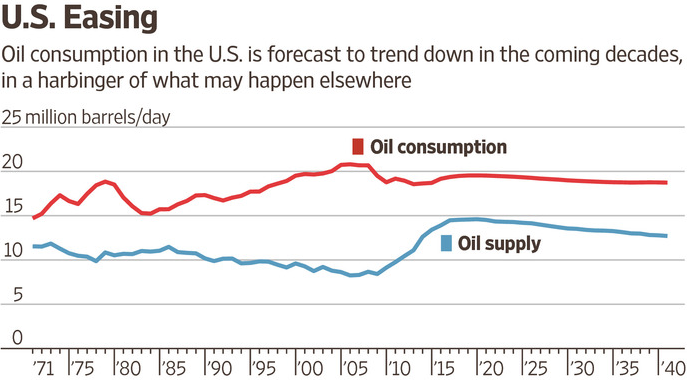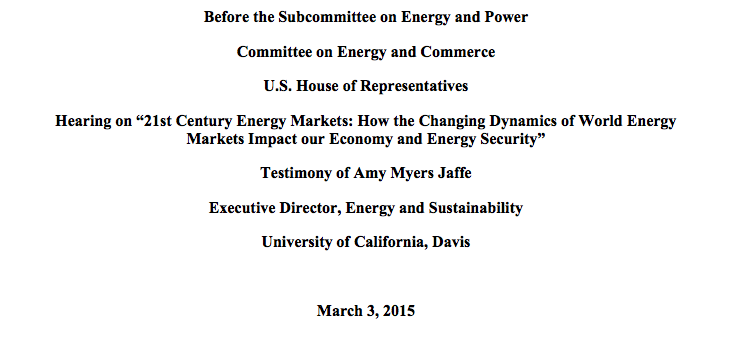By Amy Myers Jaffe
When it comes to oil demand, the conventional wisdom is clear: Population growth and a rising global middle class guarantee that demand—and prices—will rise over the coming decades. It is a story line that is almost universally accepted by investors, governments and industry alike.
But like many such consensus views, it is one that should be treated with caution.
The world’s economy is experiencing transformational changes that, I believe, will dramatically alter patterns of energy use over the next 20 years. Exponential gains in industrial productivity, software-assisted logistics, rapid urbanization, increased political turmoil in key regions of the developing world, and large bets on renewable energy are among the many factors that will combine to slow the previous breakneck growth for oil.
The result, in my opinion, is as startling as it is world-changing: Global oil demand will peak within the next two decades.
The geopolitical and economic implications of peaking demand will be huge. The fall in the importance of Saudi Arabia is already palpable, with all the major powers from the U.S. to China more willing to accommodate Saudi archrival Iran. In addition, Russia’s ability to use oil as a weapon will wane, as will the economic leverage of the Organization of the Petroleum Exporting Countries. As economic growth becomes increasingly disconnected from oil, world powers will likely shift their attention to other increasingly scarce resources that will be equally critical to economic well-being, such as food, water and minerals. A greater interest in Africa, for example, is already starting to emerge.
For sure, peak demand is far from how the oil patch sees things. The oil industry’s operating premise is that a rising global middle class from China, India, Indonesia, Malaysia, Thailand and parts of Africa and the Middle East will translate into soaring car ownership and fuel consumption. Officially, the International Energy Agency forecasts oil demand rising to 104 million barrels a day by 2040 from 90 million barrels a day in 2013, as surging demand in the developing world dwarfs the demand declines expected in the industrialized countries.
But I believe this forecast misses on both fronts—underestimating the extent of the decline in demand for oil in the developed world and overestimating the extent of the rise in the developing countries.
Signs of change are already apparent. Most everyone agrees, for instance, that a combination of policy inducements, energy taxes and technological breakthroughs has resulted in a peak in oil demand in the largest industrialized economies. Europe’s oil use last year hit its lowest level since the mid-1990s. The U.S. Energy Information Administration declared 2007 as the peak year for oil use in the U.S., with demand expected to fall by between 1.8 million and 2.7 million barrels a day by 2035 based on improvements in automotive efficiency and demographic trends.
Moreover, signs are emerging of slowing oil demand even in China, which has been the biggest source of growth in consumption over the past decade. Diesel demand in China fell in each of the past two years, raising doubts about how much longer China’s economy will require a growing supply of oil. China Petroleum & Chemical Corp., one of China’s largest fuel marketers, recently said on a call with analysts that China’s diesel demand could peak by 2017 and gasoline by 2025 as the country transitions to less-energy-intensive activities and sees through an aggressive national energy policy that promotes renewable energy and advanced automotive technology at home and for export.
IT efficiencies
But these trends are just the beginning of what will be a gradual shift that will eventually get the whole world to a peaking of oil demand.
Let’s start with the most important: the advent of information technology and big data, which are bringing revolutionary changes to daily life, especially for millennials. Exponential gains in productivity are expected for everything from transportation logistics to industrial equipment, which together with the growth of the sharing economy offer potentially dramatic savings on energy use.
We all know how much we optimize routing, timing, loading and sharing through the use of our own mobile devices. Mobile apps that help drivers avoid traffic congestion save fuel, for example, since idling in traffic wastes about 2.9 billion gallons of fuel a year in the U.S.
What might be less obvious is how this combination of satellite imagery, remote sensors, communications technology, cloud-based computing, robotics and “smart” industrial machinery is reducing the amount of fuel needed in other kinds of economic activity. Big-data analytics applied to aviation navigation is already shaving 10% to 20% off fuel demand, and similar advances are expected in the rail industry. Manufacturing via automation and 3-D printing are also expected to reduce fuel requirements.
Business-as-usual oil forecasts are also predicated on a rising need for consumer plastics, but this, too, may prove wildly overstated. Roughly 5% of global oil consumption goes to plastics production.
While it is hard to eliminate plastics from daily life, consumer companies have been trying to reduce their plastics footprint, in part in response to millennial consumers who are pushing companies to reduce waste, lower carbon emissions and eliminate landfills through intelligent design, smarter materials and recycling. Global retailers, such as apparel companies, are moving away from plastic packaging, and car companies are considering similar strategies that would curb demand for plastics substantially.
Fewer car commuters
Rapid urbanization may also point to a future drop in oil demand. Cities currently account for about 66% of global energy use, with forecasters projecting that figure to rise to 80% as the population shifts to urban centers.
But this trend of massive urbanization will more likely reduce the viability of private car ownership in the very places that are supposed to serve as the new centers of oil use, such as India, Indonesia and the Arab Gulf. Chances are, air-pollution concerns and congestion in mega-cities will prevent giant increases in the number of cars, and therefore hinder the substantial rise in oil demand that forecasters are expecting.
Increasingly, cities around the world are seeking smarter designs for transport systems as well as penalties and restrictions on car ownership. Already in the West, trendsetting millennials are urbanizing, eliminating the need for commuting and interest in individual car ownership, just as their baby-boomer parents are retiring and driving less.
At the same time, increased turmoil and low oil prices are crippling economic activity in parts of the Middle East and Africa, the two regions that are supposed to be the big drivers of continued growth in oil use. The wealth-accumulation prospects for the middle classes in these societies are uncertain—and so, therefore, is their demand for oil. What’s more, many state-sponsored fuel-price subsidies, which have been a key driver of oil demand in the developing world, are rapidly disappearing.
Finally, renewable energy is turning out to be more promising than expected, eating away at oil’s share of electricity production—and, eventually, automotive energy. China’s commitment to an industrialization program pushing itself to be the world’s major exporter of solar panels and advanced vehicles, including the production of five million electric vehicles a year, is another source of caution to those who forecast oil demand will rise exponentially forever.
None of this is set in stone, of course. A lot could change in the coming years—economically, politically, technologically—that could alter the oil-demand equation. But as Paris climate talks approach, governments around the world will be working to highlight their energy-efficiency policies and sharing information on how to lower oil intensity for the global economy. Whatever collective gains they make could seal the deal for peak demand.





